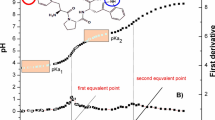Abstract
An approach to the design of dipeptide neuroleptics free of extrapyramidal effects is described. Proceeding from an original hypothesis about the peptidergic mechanism of action of the atypical neuroleptic drug sulpiride and using the method of drug-based peptide synthesis, a peptide prototype of sulpiride — Pro-Tyr-NH2 dipeptide — was obtained whose neuroleptic activity and the absence of cataleptogenic properties were revealed by tests on experimental animals. An analysis of the structures of known neuropeptides showed that the Pro-Tyr dipeptide sequence coincides with a Pro10-Tyr11 fragment of the tridecapeptide neurotensin referred to in the literature as a neuropeptide with neuroleptic properties. Further design based on the obtained active dipeptide structure and the supposed bioactive β-rotational conformation of the neurotensin 8 – 13 sequence led to a group of new potential atypical neuroleptics, N-acylprolyltyrosines. The structure of these tripeptoid analogs of neurotensin contains an N-acyl group imitating the Leu13 side chain of neurotensin, which plays an important role in receptor binding. One of these compounds, N-caproyl-L-prolyl-L-tyrosine methyl ester, was named Dilept and chosen for more extensive pharmacological characterization as a potential antipsychotic agent. Preclinical investigations showed that Dilept is effective in doses 0.4 – 4.0 mg/kg (i.p.) and retains activity upon peroral administration. The drug is nontoxic and does not induce extrapyramidal disorders even when administered in amounts 1000 times higher than the effective dose.
Similar content being viewed by others
REFERENCES
V. E. Klusha, Peptide Based Regulators of Brain Functions [in Russian], Zinatne, Riga (1984).
R. U. Ostrovskaya, T. A. Gudasheva, T. A. Voronina, and S. B. Seredenin, Eksp. Klin. Farmakol., 65(5), 66–72 (2002).
T. A. Gudasheva, R. U. Ostrovskaya, S. S. Trofimov, et al., Khim.-Farm. Zh., 19(11), 1322–1324 (1985).
T. A. Gudasheva, T. A. Voronina, R. U. Ostrovskaya, et al., Eur. J. Med. Chem., 31(2), 151–157 (1996).
T. A. Gudasheva and A. P. Skoldinov, Eksp. Klin. Farmakol., 66(2), 15–19 (2003).
M. D. Mashkovskii, Drugs [in Russian], Novaya Volna, Moscow (2001), Vol. 1, p. 73.
C. F. Caley and S. S. Weber, Ann. Pharmacother., 29(2), 152–160 (1995).
T. A. Gudasheva, N. I. Zaitseva, N. A. Bondarenko, et al., Khim.-Farm. Zh., 31(11), 10–16 (1997).
N. C. Cohen (ed.), Guidebook on Molecular Modeling in Drug Design, Academic Press, London (1996), p. 252.
C. B. Nemeroff, Biol. Psychiatry, 15(2), 283–302 (1980).
I. I. Baskin, N. I. Zaitseva, and T. A. Gudasheva, Abstrs. of the International Symposium Computer Assistance to Chemical Research, Moscow (1996), p. 61.
M. T. Garcia-Lopez, M. J. Dominguez, R. Gonzalez-Muniz, et al., in: Peptides 1992: Proceedings of the 22nd Eur. Peptide Symp., C. H. Schneider and A. N. Eberle (eds.), ESCOM Sci. Pub., Leiden (1993), pp. 623–624.
Y.-P. Pang, J. Zaidi, A. P. Kozikowski, et al., J. Comp.-Aided Mol. Design, 8(4), 433–440 (1994).
Y.-P. Pang, B. Cusack, K. Groshan, et al., J. Biol. Chem., 271(25), 15060–15068 (1996).
T. A. Gudasheva, T. A. Voronina, R. U. Ostrovskaya, et al., J. Med. Chem., 41(3), 284–290 (1998).
N. I. Zaitseva, T. A. Gudasheva, V. K. Briling, et al., Khim.-Farm. Zh., 34(8), 20–22 (2000).
K. Fuxe, G. Von Euler, L. F. Agnati, et al., Ann. N Y Acad. Sci., 668, 186–204 (1992).
S. B. Seredenin, T. A. Voronina, T. A. Gudasheva, et al., RF Patent No. 2091390 (1997); Chem. Abstr., 125, 453a (1998).
N. A. Bondarenko, M. V. Retyunskaya, T. A. Gudasheva, et al., Abstracts of Papers. The 2nd Meeting of the Russian Scientific Society of Pharmacologists [in Russian], Moscow (2001), Part 1, p. 73.
L. S. Asmakova, T. S. Kalinina, R. U. Ostrovskaya, et al., Pharm. Biochem. Behavior., 64(2), 359–362 (1999).
L. S. Guzevatykh, R. U. Ostrovskaya, T. A. Gudasheva, et al., Eksp. Klin. Farmakol., 65(1), 3–6 (2002).
R. Ostrovskaya, T. Gudasheva, L. Guzevatich, et al., Behav. Pharmacol., 14(Suppl. 1), S 32 (2003).
N. I. Zaitseva, V. P. Lezina, A. N. Ignashin, et al., Khim.-Farm. Zh., 35(7), 35–38 (2001).
N. I. Zaitseva, T. A. Gudasheva, R. U. Ostrovskaya, et al., Khim.-Farm. Zh., 37(5), 3–6 (2003).
Author information
Authors and Affiliations
Additional information
Dedicated to the memory of our dear tutor Aleksandr Petrovich Skoldinov.
__________
Translated from Khimiko-Farmatsevticheskii Zhurnal, Vol. 39, No. 5, pp. 6 – 11, May, 2005.
Rights and permissions
About this article
Cite this article
Gudasheva, T.A., Zaitseva, N.I. Design of the Neurotensinergic Dipeptide Neuroleptic Drug Dilept. Pharm Chem J 39, 230–235 (2005). https://doi.org/10.1007/s11094-005-0123-y
Received:
Issue Date:
DOI: https://doi.org/10.1007/s11094-005-0123-y




